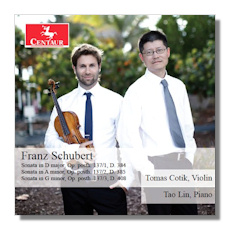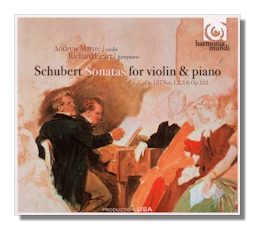
The Internet's Premier Classical Music Source
Related Links
- Schubert Reviews
- Latest Reviews
- More Reviews
-
By Composer
-
Collections
DVD & Blu-ray
Books
Concert Reviews
Articles/Interviews
Software
Audio
Search Amazon
Recommended Links
Site News
 CD Review
CD Review
Franz Schubert

Complete Works for Violin & Piano, Volume 2
- Violin Sonata in D Major, Op. posth. 137 #1 (D. 384)
- Violin Sonata in A minor, Op. posth. 137 #2 (D. 385)
- Violin Sonata in G minor, Op. posth. 137 #3 (D. 408)
Tomas Cotik, violin
Tao Lin, piano
Centaur CRC3412 55:30


Violin Sonatas
- Sonata for Violin & Piano #1, D. 384 (Op. posth. 137 #1)
- Sonata for Violin & Piano #2, D. 385 (Op. posth. 137 #2)
- Sonata for Violin & Piano #3, D. 408 (Op. posth. 137 #3)
- Sonata for Violin & Piano in A major, D. 574 (Op. 162)
Andrew Manze, violin
Richard Egarr, fortepiano
Harmonia Mundi HMU907445 78:35 2007
The Three Sonatas, Op. 137 were published as Sonatinas, but Schubert called them Sonatas. One can find recordings under both titles. He wrote the Op. 137 violin and piano works when he was nineteen years old – at the time he was writing his Fourth Symphony, Brian Newbould tells us, and he did not return to the genre.
Schubert was one of the great melodists, and all these performances certainly show that. I have known and loved much of Schubert's music all my life. He wrote so much that few can claim to have heard all that he wrote in his short life of 31 years. I never bonded with any particular performances of these Sonatas. I could not say the same about Schubert's late symphonies. I have always had passionate feelings about Schubert's Unfinished and Great C Major Symphonies performed by their great interpreters, but up to now I have never felt a strong connection with these particular chamber works, nor have I heard many of the staggering number of recordings listed in ArkivMusic's online catalog.
That said, I have to confess that I find it much easier to review new works with no previous recording history than some like these. I have not heard the Zukerman/Neikrug performance – which Robert Maxham says (in the current Fanfare) has "beguiling beauty" and "grand manner"; but I did have on hand the Manze/Agarr recording. I looked at no reviews of these recordings before listening to both of them several times and developing my own assessments and preferences. I will report that Maxham raved about Cotik/Lin's previous release and I reviewed highly favorably on this site two of Cotik's: his "solo" (Centaur CRC3374) and his Piazzolla (Naxos 8.573166) albums.
I can say that the Cotik/Lin performances are clear, crisp and vigorous, and undoubtedly informed by Cotik's doctoral dissertation on Schubert. Tempos are generally brisk, except in the opening movement of Sonata #1, which has a very deliberate beginning. Cadences are emphatic, most notably in the Minuets (which remind me of those used by Carl Davis in the BBC film of Pride and Prejudice.) Most of their interpretations leave little to be desired. I have to admit I was initially put off by the opening of the movement at the beginning of the disc. Also the recording tends to favor the piano; the violin sound is often recessive. Otherwise, this is a very impressive disc.
Manze and Egarr, unlike Cotik, are new to this repertoire, having previously been busy recording baroque music (as has Cotik) and the Harmonia Mundi album note speaks of their "fresh and different Schubert." Their performances are indeed fresh, and different from Cotik/Lin. Egarr's pianoforte is less dominant than the modern piano of Lin, and I was most impressed with the duo's subtly varied expressiveness. In general they had a lighter and more fluid approach to the music, with less staccato and more legato.
I can recommend both of these recordings, and I should think that lovers of Schubert's music would wish to experience both performances.
Copyright © 2015, R. James Tobin





















